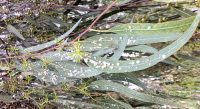It is a hemiptera/ homoptera insect. The adult measures 2-3 mm and is greenish with orange spots. The nymphs measure over 2 mm and typically shelter under protective covers, in the form of white shells and with a filamentous texture (
Fig. a), of about 3 mm, made from sugars; people easily get them mixed up with cochineal insects. The eggs measure less than 1 mm, are yellowish in colour and are arranged individually or in groups. They can develop several generations per year.

Fig. a – Eucalyptus leaf with presence of Glycaspis adults, nymphs, eggs and shells.
The leaves are infested by the whitish shells where the nymphs shelter (
Fig. b), leaving all the surroundings of the tree filled with these shells when they detach from the leaves.
It also causes the weakening of the plant, due to the nymphs suctioning the sap. Severe chlorosis, wilt and premature leaf fall may occur in the face of severe attacks.
As with aphids or cochineal infestations, this psylla produces a strong honeydew secretion and its collateral damage, that is, the appearance of sooty mould or inconveniences in the field of ornamental matters.

Fig. b – Eucalyptus affected by Glycaspis.
Preventive treatment with plant endotherapy (ENDOterapia Vegetal®) to avoid the occurrence of problems. Preventive treatment is generally recommended in late spring, when the first infestations are detected.







